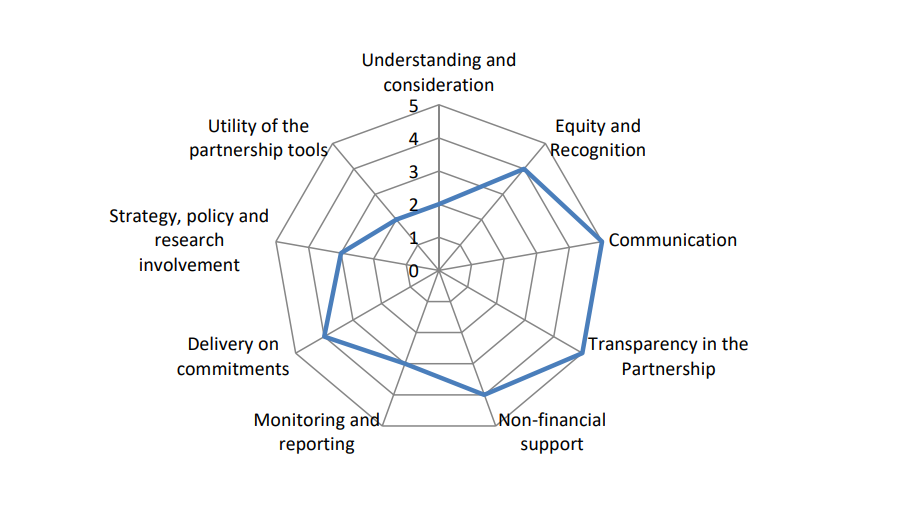Section 02: Before the exit/transition
2.1: Design exit/transition into new partnerships from the start
One of the most common exit challenges for INGOs, is when they have had very long-standing partnerships with national civil society partners. These partnerships may have lasted for decades, and the original rationale for the partnership might have been forgotten a long-time ago. But there’s a sense of loyalty to keep the partnership going, and talking about exit has become a ‘taboo’ topic.
So there are several things that you can do at the start of any new partnership, to help to set it up for success. These are captured in this checklist for new partnerships, and key points that relate to exit/transition are:
Avoid creating dependency
Be transparent
Remember to schedule regular ‘partnership reviews’ from the start
Design for sustainability from the start of new programmes/projects.
2.1.1: Avoid creating dependency
Over-dependency on INGO inputs results in unhealthy partnerships & means long- term initiatives are likely to fail. Make sure that the type and scale of delivery and levels of funding involved wouldn’t overwhelm your partners, and that you engage with and support local power structures that hold legitimacy, power and agency at community-level for maximum chances of success.
2.1.2. Be transparent
Transparency helps to create trust. You can help to create healthy partnerships from the start by developing a simple Partnership Strategy or Policy, to share with your partners. This explains how you work with partners, your ‘partnership principles’ if you have them e.g. ‘equity’, ‘transparency’, and what the partner onboarding process is (e.g. if a due diligence process is involved) plus what they can expect from you (e.g. equivalent organisational information, partnership reviews). It should also signal how long you will typically work with partners for, and how decisions to exit or transition will be made.
Make sure you also discuss how long you and the partners anticipate being in a partnership for early on, and what ‘type’ of partnership you believe this to be from the start. These things can change over time, but being clear from the start will create a solid foundation for open dialogue with partners and ensure you all see things in the same way. Is the partnership reliant on access to funding, or is it bigger than that?
Example: Carers Worldwide
Carers Worldwide works with partners in India, Nepal and Bangladesh. From day one of their partnerships, they were open about their strategy to work with local organisations as ‘implementing partners’ for a maximum of seven years, before graduating to becoming ‘resource network members’. This will involve new, paid responsibilities e.g. providing training and support for new implementing partners.
2.1.3: Remember to schedule moments for regular ‘partnership reviews’ from the start
This is when you can discuss and review how the collaboration is going as well as the projects themselves. Remember to share organisational updates, review what’s going well (including how you’re working together), address any partnership challenges and identify actions that will help your partnership to be more effective in the future.
It’s also a chance to talk about the future of the partnership, to ensure that you’re on the same page and there are no surprises.
You can find an example of a ‘partnership review’ process and template which was used by a former INGO called EveryChild.
A guide to partnership reviews developed by the World Wildlife Foundation (WWF) is available here.
2.1.4: Design for sustainability from the start of new programmes/projects
At the start of a new programme/project, it’s important to consciously incorporate questions about sustainability into your needs assessment & project design, as well as your monitoring frameworks. This involves:
Talking honestly about sustainability.
Think about which activities you expect to stop at the end of the project, and which need to continue to have a lasting impact and to avoid doing harm. For sustainability planning to be effective, the same stakeholders who are often already overstretched and under- resourced would need to have sufficient capacity take on any additional responsibilities that would continue after the project ends - ideally during a gradual transition period. This requires the active buy-in and consent of the stakeholders regarding any responsibilities they are expected to take on at the end of the project from the start.
Planning for a tapered exit from the start.
If the plan is initially for INGO staff to deliver any technical activities which would later be delivered by partner staff, ensure you build in a transition period.This means agreeing when INGO staff will shift from ‘leading’ to ‘supporting’ and how this will be done e.g. through mentoring, shadowing etc. It can also be helpful to plan for a transition period for up to a year after the end of the programme, to provide ongoing technical backstopping and mentoring e.g. in programme management and advocacy. This has the potential to enable former partners to continue to grow their capacity and confidence post-exit.
Capturing key agreements in a Partnership Agreement / MOU.
This should lay out your overall partnership aims and preferred ways of working, partnership principles, governance arrangements etc. It can be open-ended our time bound, and serves a different purpose to your individual project/grant agreements.
Last updated
